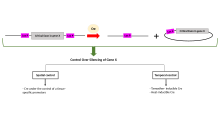
In genetic engineering, floxing refers to the insertion of a DNA sequence (which is then said to be floxed) between two LoxP sequences, creating an artificial gene cassette which can then be conditionally deleted (knocked out), translocated, or inverted in a process called Cre-Lox recombination.[1] Recombination between LoxP sites is catalysed by Cre recombinase. The term "floxing" is a portmanteau constructed from the phrase "flanking/flanked by LoxP".
The floxing method is essential in the development of scientific model systems as it allows researchers to have spatial and temporal alteration of gene expression.[2] The Cre-Lox system is widely used to manipulate gene expression in model organisms such as mice in order to study human diseases and drug development.[3] For example, using the Cre-Lox system, researchers are able to study oncogenes and tumor suppressor genes and their role in the development and progression of cancer in mouse models.[4]
- ^ Nagy A (February 2000). "Cre recombinase: the universal reagent for genome tailoring". Genesis. 26 (2): 99–109. doi:10.1002/(SICI)1526-968X(200002)26:2<99::AID-GENE1>3.0.CO;2-B. PMID 10686599. S2CID 2916710.
- ^ Hayashi S, McMahon AP (April 2002). "Efficient recombination in diverse tissues by a tamoxifen-inducible form of Cre: a tool for temporally regulated gene activation/inactivation in the mouse". Developmental Biology. 244 (2): 305–18. doi:10.1006/dbio.2002.0597. PMID 11944939.
- ^ Mouse genetics : methods and protocols. Singh, Shree Ram,, Coppola, Vincenzo. New York, NY. 26 July 2014. ISBN 9781493912155. OCLC 885338722.
{{cite book}}: CS1 maint: location missing publisher (link) CS1 maint: others (link) - ^ Green JE, Ried T (2012). Genetically Engineered Mice for Cancer Research. doi:10.1007/978-0-387-69805-2. ISBN 978-0-387-69803-8. S2CID 40599715.